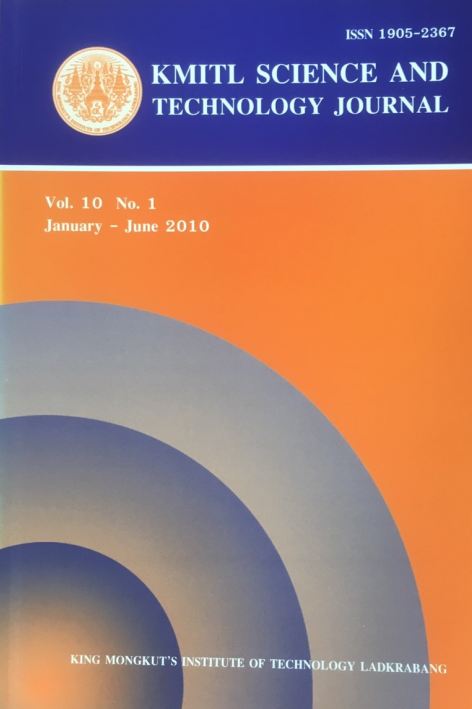The Production of Biogas from Cassava Tubers
Main Article Content
Abstract
We utilized a two-phase fermentation process for biogas production under anaerobic conditions using raw cassava tubers as substrate. Fifty grams of dried cassava tubers were ground, mixed with 200 ml of water and added into an acid tank with a working volume of 6 L. The methane tank had a working volume of 21 L. Fermentation was performed at ambient temperature with an average of 33oC using seed culture from Kasetsart University (10% v/v). The highest biogas produced from the methane tank was 13.20 L per day after a fermentation period of 31 days. The efficiencies for the removal of COD, total solids, volatile solids and volatile fatty acids were 86.21, 84.11, 92.44% and 5,745 mg/l, respectively. The methane content of the biogas produced in this study was 64.3%.
Keywords: Biogas, methane, cassava, anaerobic condition
*Corresponding author: Tel: 662-5625555
E-mail: fscipms@ku.ac.th
Article Details
Copyright Transfer Statement
The copyright of this article is transferred to Current Applied Science and Technology journal with effect if and when the article is accepted for publication. The copyright transfer covers the exclusive right to reproduce and distribute the article, including reprints, translations, photographic reproductions, electronic form (offline, online) or any other reproductions of similar nature.
The author warrants that this contribution is original and that he/she has full power to make this grant. The author signs for and accepts responsibility for releasing this material on behalf of any and all co-authors.
Here is the link for download: Copyright transfer form.pdf
References
[2] Wikie, A. C. 2004. Biogas and anaerobic digestion: fundamentals and applications. [Online].
Available: www.cityofpaloalto.org/civica/filebank/blobdload.asp?BlobID=15431
[3] Schaumann Bioenergy. 2010. Biogas production- a complex process. [Online]. Available: www.schaumann-bioenergy.eu.com/PDF/en/biogasproduktion/fermenterbiplogie/pdf_ biogas _production.pdf
[4] Schlegel, M., Kanswohl, N., Rossel, D. and Sakalauskas, A. 2008. Essential technical parameters for effective biogas production. Agronomy Research, 6 (special issue), 341-348.
[5] Cheng, Xi-Yu and Liu, Chun-Zhao. 2010. Enhanced biogas production from herbal-extraction process residues by microwave-assisted alkaline pretreatment. Journal of Chemical Technology and Biotechnology, 85, 127-131.
[6] Vinneras, B., Schonning, C. and Nordin, A. 2006. Identification of the microbiological community in biogas systems and evaluation of microbial risks from gas usage. Science of the Total Environment, 367, 606-615,
[7] Lebuhn, M. and Gronauer, A. 2009. Microorganisms in the biogas-process-the unknown Beings. Landtechnik, 64, 127-130.
[8] Wuungkobkiat, A., Sawanon, S. and Sirirote, P. 1996. Swine manure wastewater treatment and biogas production by using EM. Kasetsart Journal (Natural Science), 30, 219-226.
[9] Rittmann, B. E. and McCarty, P. L. 2001. Environmental Biotechnology: Principles and
Applications. McGraw-Hill International Editions, Singapore.
[10] Paepatung, N., Nopharatana, A. and Songkasiri, W. 2009. Bio-methane potential of biological
solid materials and agricultural wastes. Asian Journal on Energy and Environment, 10 (01), 19-27.
[11] Department of Alternative Energy Development and Efficiency, Ministry of Energy. 2009. [Online]. Available: http://www.dede.go.th/dede/fileadmin/upload/nov50/ mar52/ REDP_
[12] Office of Agricultural Economics, Ministry of Agriculture and Cooperatives. 2008. [Online]. Available: http://www.oae.go.th/oae_website/oae_area.php present.pdf
[13] Tapioca. 2010. [Online]. Available: http://tapiocathai.org
[14] Anunputtikul, W. 2004. Biogas production from cassava tuber. M.Sc. Thesis. Suranaree University of Technology, Nakhon Ratchasima.
[15] AOAC. 2000. Official Methods of Analysis of the Association of Official Analytical Chemist. 11th ed. The Association of Official Analytical Chemist, Washington D.C.
[16] Naranong, N. 1996. Water Quality Analysis Laboratory. King Mongkut’s Institute of Technology Ladkrabang, Bangkok.
[17] Arnold, E. G. 1992. Standard Methods for the Examination of Water and Wastewater. American Public Health Association, New York.
[18] Panswad, T. and Wisuttisak, W. 1997. Manual of Wastewater Analysis. 3rd ed. Chulalongkorn University, Bangkok.
[19] Anunputtikul, W. and Rodtong, S. 2004. Laboratory scale experiments for biogas production from cassava tubers. In The Joint International Conference on “Sustainable Energy and Environment (SEE)”, pp. 238-243. December 1-3, 2004, Hua Hin, Thaialnd.
[20] Naranong, N. and Phensaijai, M. 1999. Water and Wastewater Treatment. King Mongkut’s Institute of Technology Ladkrabang, Bangkok.
[21] Li, R., Chen, S. and Li, X. 2010. Biogas production from anaerobic co-digestion of food waste with dairy manure in a two-phase digestion system. Appl. Biochem Biotechnol 160:643-654.


